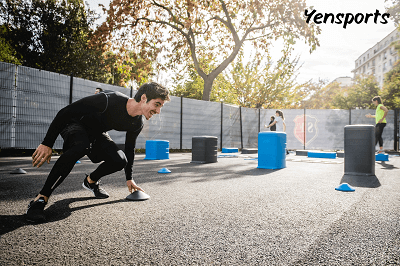Fascia Training by Danny Foley: Unlocking the Secrets of Connective Tissue for Improved Mobility and Performance
Fascia training remains a relatively new concept in terms of its popularity in the fitness and rehabilitation world. Among the pioneers involved in this revolutionary approach is a leading practitioner and educator. Danny Foley, on fascia and human movement. This post will explore what fascia training is, and the principles behind it. And how it has influenced us to look at connective tissue, mobility, and performance through the methods of Danny Foley.

What is Fascia?
Fascia is the connective tissue that surrounds muscles, bones, nerves, and organs in the body. It is a dense fibrous network that provides structural integrity support and facilitates communication between parts of the body. The fascial system is a continuum, which plays an important role in movement efficiency, flexibility, and general physical performance.
Fascia is not just a passive structure; it is an active tissue that can adapt, stretch, contract, and even store energy. Research has shown that fascia is densely packed with sensory receptors, making it an essential part of our proprioceptive system, which helps us understand the position and movement of our body in space.
What is Fascia Training?
Fascia training is a specialized form of exercise aimed at optimizing the function and health of the fascial system. It differs from standard strength training, which generally seeks to isolate muscles and to work joint movement, as fascia training emphasizes the entire network of the body’s fasciae. The objective is flexibility, mobility, and resiliency, by means of dynamic, whole-body movement, mimicking natural patterns.
Danny Foley, a famous fascia training instructor, designed a program that encompasses techniques that exploit the flexibility, elasticity, and tension of fascia. His style is meant to maximize the efficiency of energy storage and release regarding the effects of “elastic recoil” in fascia. Once properly trained, fascia maximizes performance, reduces potential injury, and increases total movement efficiency.
Danny Foley’s Approach to Fascia Training:
The work of Danny Foley is an extension of dynamic exercising, often using tools like foam rollers, resistance bands, or devices for vibration therapy to stimulate the fascial tissue. It is not merely stretching the fascia but actively engaging it through multidimensional, functional movements.

Techniques to release fascial restrictions, enhance hydration in connective tissue, and stimulate the manufacture of ground the gel-like component that keeps fascia healthy and lubricated. Some of the most important ideas in his curriculum include the following:
-
Whole-Body Movements:
Not the isolated exercises of yesteryear, but coordinated, compound movements that enlist multiple sets of muscles and fascial chains all at one time.
Fascia can absorb and release energy. Exercises in Foley’s training program increase the elasticity and resistance of the fascial system to tension, thus permitting explosive and effective movements.
-
Self-Myofascial Release:
Foam rolling and other forms of self-massage are common practices in training the fascia. Such techniques break up adhesions in the fascia, improve circulation, and recover mobility in areas that might be stiff or tight in the body.
-
Proprioception and Awareness:
The practice of fascia training also helps improve body awareness through improved communication between the muscles and the nervous system, thereby giving rise to better coordination, posture, and movement control.
Benefits of Fascia Training:
Several benefits come with fascia training, such as:
- Improved Mobility and Flexibility: Fascia training can increase the range of motion in joints and muscles releasing tightness in the fascial tissue.
- Preventing Injury: Because of an increase in fascia’s elasticity, this kind of training avoids injuries caused by overuse, strain, or bad posture.
- Better Athletic Performance: Since fascia is the storage and transfer system within the body, training fascia can achieve better movement patterns and high power.
- Pain Relief: Most chronic pain conditions are fascial restrictions – back pain, plantar fasciitis, etc. Practice releases tension in the body, and alleviates discomfort in those areas.
Frequently Asked Questions about Fascia by Danny Foley:
1. How often should I include fascia training in my practice?
Depending on your goals and fitness status, fascia can be repeated several times a week. Start from 2-3 times per week and progress, if needed, since beginners’ bodies require time to get used to it.
2. Can the fascia be used for beginners?
Yes, fascia is suitable for beginners, but it’s essential to start slowly and gradually build up your flexibility and mobility. Many of the exercises can be modified to accommodate different fitness levels.
3. Do I need special equipment for fascia training?
Most of the people familiar with tools, for instance, use foam rollers, resistance bands, and vibration devices; however, one can still train on their body weight alone. It is more of a movement pattern than of tools used.
4. Is fascia beneficial to someone suffering from chronic pain?
Yes, fascia training can be very effective for chronic pain conditions, especially those caused by fascial tightness, such as lower back pain or shoulder stiffness. Regular practice helps to release fascial restrictions, improving circulation and reducing discomfort.
5. How long does it take to see results from fascia training?
This, therefore, means that the timelines will differ as the individual’s starting point will also vary, and so will consistency. Some people improve mobility and flexibility within weeks while others will take longer. The two ingredients for this are consistency and patience.
Conclusion:

Danny Foley’s techniques for training fascia improve overall performance in a comprehensive way with his techniques based on connective tissue, which underpins the entire body. From dynamic movement and self-myofascial release to improving elasticity and tension, the dynamic results that can be unlocked are impressive: better flexibility, reduced risk of injury, and an ability to achieve optimal performance in whatever activity.

